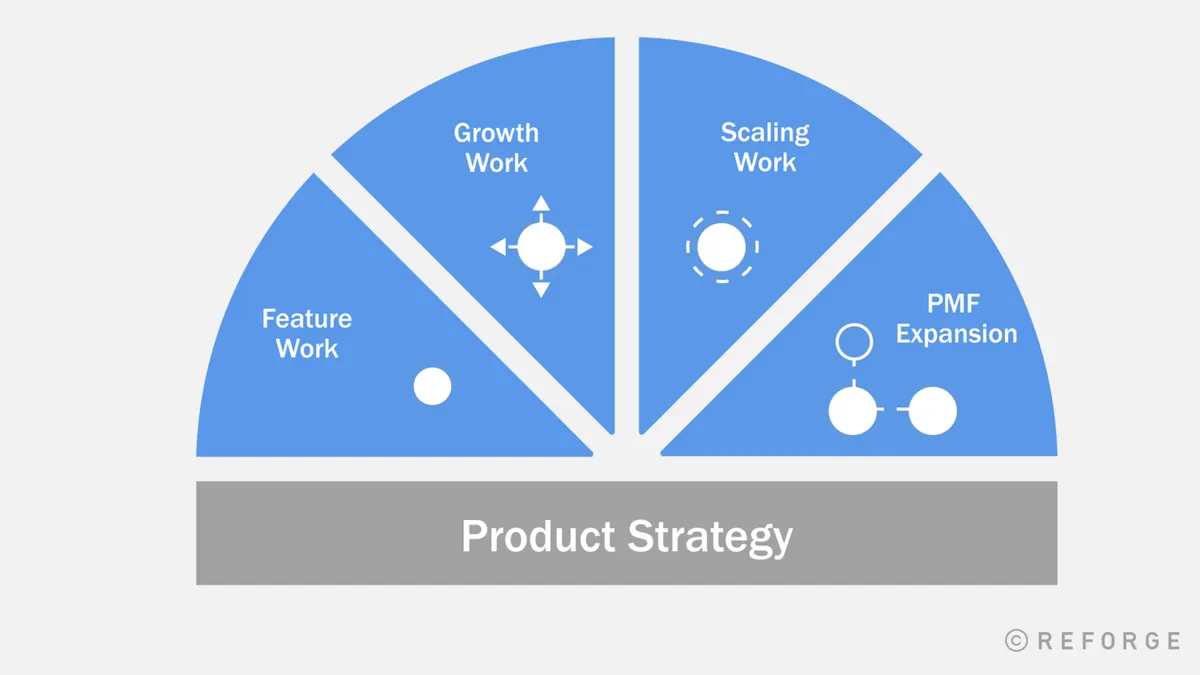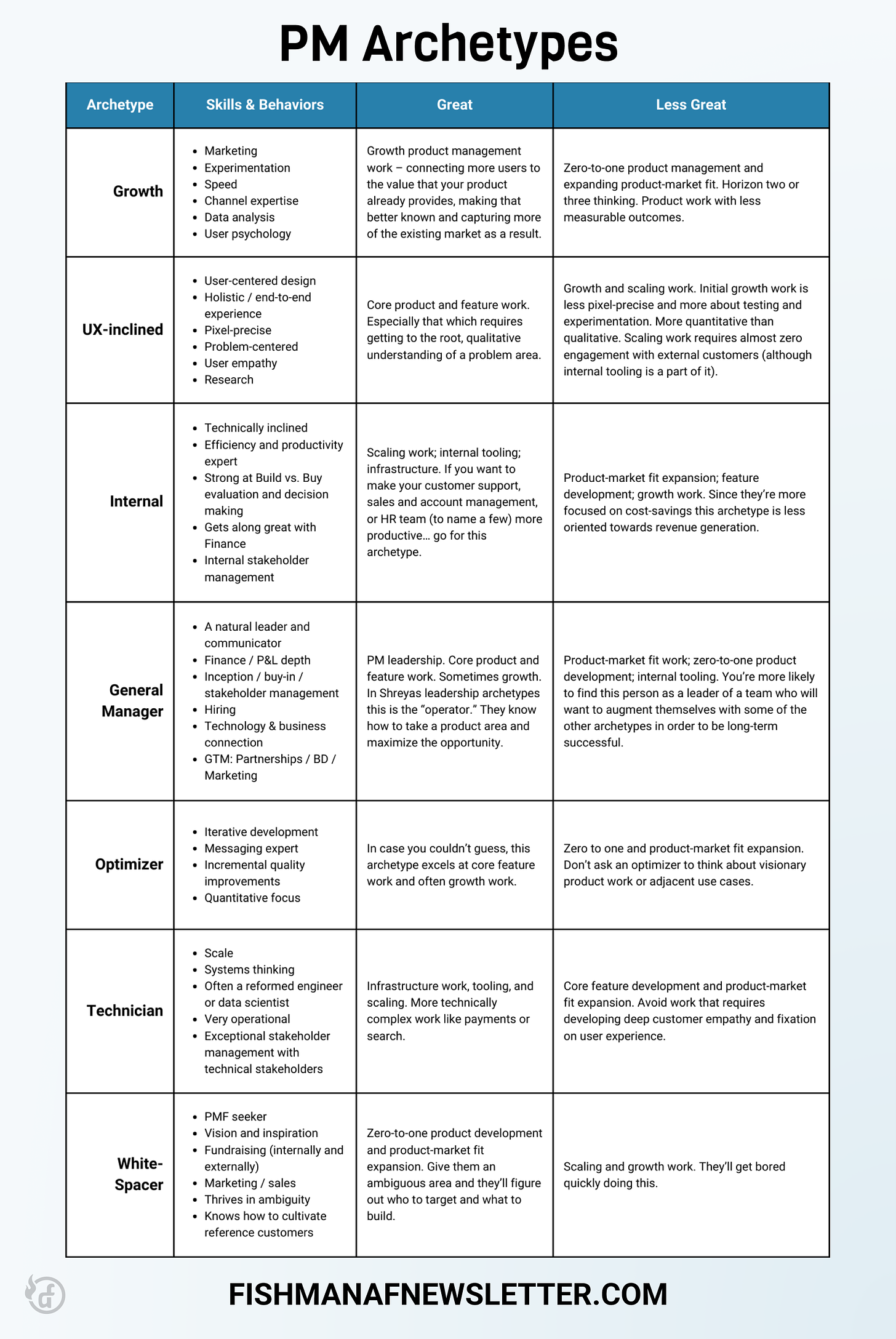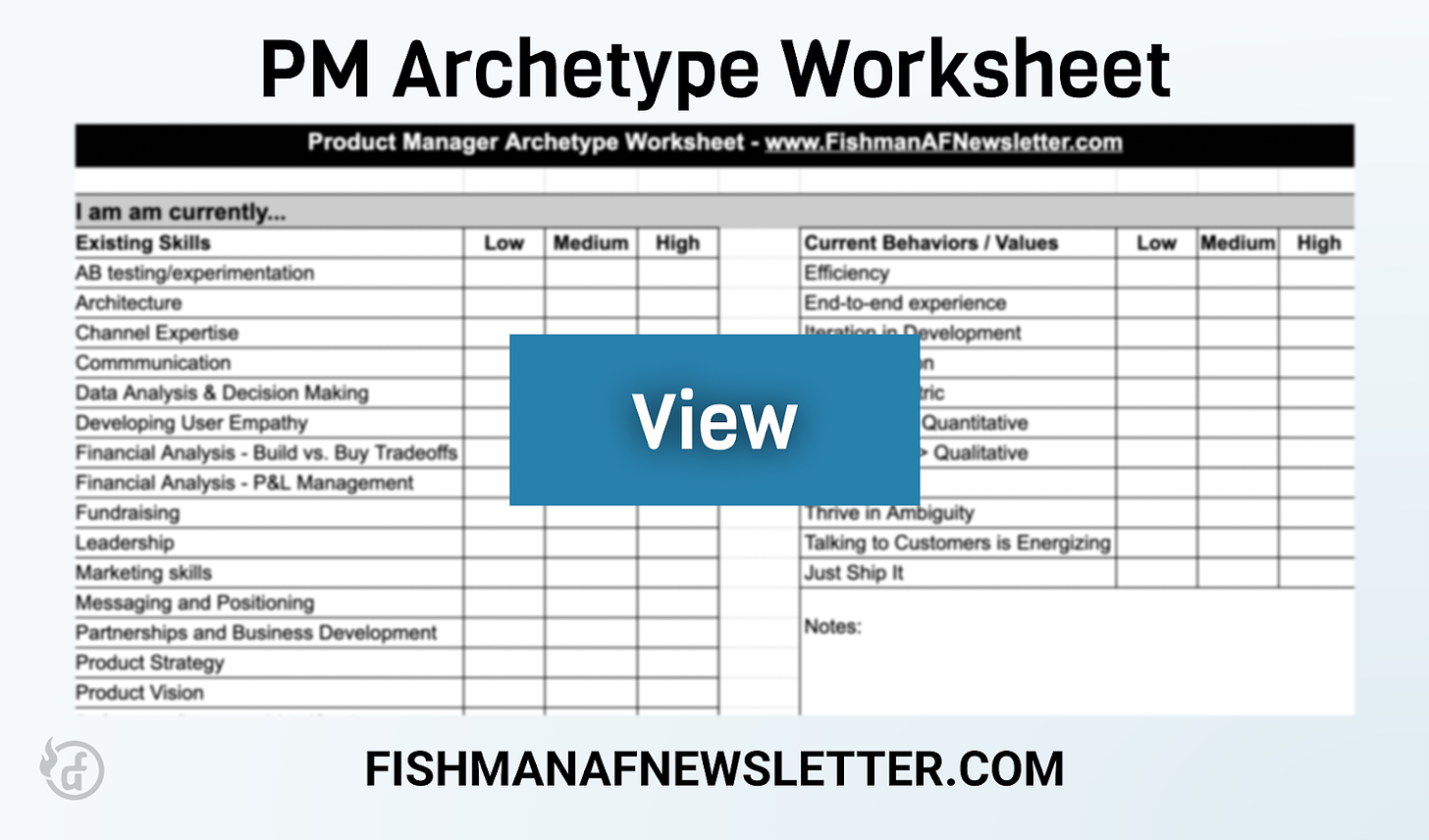Hi there, it’s Adam. I started this newsletter to provide a no-bullshit, guided approach to solving some of the hardest problems for people and companies. That includes Growth, Product, company building and parenting while working. Subscribe and never miss an issue. If you’re a parent or parenting-curious I’ve got a podcast on fatherhood and startups - check out Startup Dad. Questions you’d like to see me answer? Ask them here.
Q: How do I decide what the best product management role is for me?
Do you ever wonder if you’re well-suited for the product management role you’re in? Are you checking all the boxes of the leveling guide but still struggling to find your personal PMF? Does it sometimes seem like the grass is greener in a different part of the product organization?
You’re not alone.
I’ve written and published articles and artifacts about how to define and determine seniority and capabilities through PM leveling guides as well as the growth of specializations in Product Management. I’ve also shared how to think about competencies, archetypes, and career advancement in the world of Growth.
But I regularly come across product managers and think, “Wow, you’d be really well-suited for this type of work.” Or “Yikes, you are clearly in the wrong product role.” I also hear from people who want my referral for a specific role and wonder, “Will you be successful in this role?”
When this happens I realize that they haven’t figured out their Product Manager archetype.
In this newsletter I’ll cover:
A review of the different types of product work
What is a product manager archetype
The 7 different archetypes I’ve encountered
How to identify your archetype and what to do about it
Types of Product Work
In one of my favorite articles on types of product work, my friends Casey Winters and Fareed Mosavat identify four:
Feature - extending a product’s functionality
Growth - capture more of the existing market
Scaling - maintain the ability to ship new things you grow
PMF Expansion - expanding into adjacent products or markets
These four types of product work come after the initial quest for product-market fit. Until that point, there is no other work that matters than seeking PMF. Don’t bother.
In their article they cover that the process, metrics and strategy are distinctly different across those four types of work. What’s also true, and not in the article, is that the types of people well-suited for each are also different.
Enter Product Manager Archetypes.
What Is A Product Manager Archetype?
An archetype is a universal pattern used to describe a person. It provides a shorthand for interpreting a group of characteristics. For example, in literature if I told you that someone was “the hero” in a story you’d have a fairly good understanding of what that means and what that person is like. Yes, I know that there are now a lot of variations on what it means to be a hero; I’m not here to debate that.
I’ve written about archetypes in the past as they apply to Growth (the painter, architect and surgeon). Shreyas Doshi has written about product leader archetypes (the operator, craftsperson, and visionary).
In the Growing Specialization of Product Management, Keya and I illustrated a high-level mapping of the types of product work to the types of PM specializations:
In his article, titled “What’s Your Shape? A PM Guide to Growing Yourself and Your Team” my friend Ravi Mehta identifies four common product manager archetypes that he has encountered.
In my career I’ve identified seven product manager archetypes – let’s dig into each one.
The Seven Product Manager Archetypes
Growth Archetype
The Growth archetype has strong marketing skills and an affinity for AB testing and experimentation. She moves fast, prioritizing speed and agility (shipping) over craft (quality). The Growth PM is data driven and approaches problems more from science than art. They appreciate qualitative feedback but as a way to better understand user psychology rather than to establish empathy with their users. This archetype may come from a marketing or analytics background.
Key skills and behaviors:
Marketing
Channel expertise (e.g. SEO)
AB testing / experimentation
Speed
Quantitative data fluency
User Psychology
Great at:
Growth product management work – connecting more users to the value that your product already provides, making that better known and capturing more of the existing market as a result.
Less great at:
Zero-to-one product management and expanding product-market fit. Horizon two or three thinking. Product work with less measurable outcomes.
UX-inclined Archetype
As you might expect the UX-included archetype is profoundly committed to user-centered design. She is an excellent holistic thinker and can articulate the end-to-end product experience. This archetype is very problem-centered and is able to develop exceptional user empathy. You might expect to see this archetype come from a research background.
Key skills and behaviors:
User-centered design
Holistic thinking and end-to-end experience
Pixel-precise
Problem-centered
User Empathy
Research
Great at:
Core product and feature work. Especially that which requires getting to the root, qualitative understanding of a problem area.
Less great at:
Growth and scaling work. Initial growth work is less pixel-precise and more about testing and experimentation. More quantitative than qualitative. Scaling work requires almost zero engagement with external customers (although internal tooling is a part of it).
Speaking of which…
Internal Archetype
The internal archetype excels at navigating the intricacies of an organization. They’re inwardly focused rather than. external customer focused. This makes them efficiency experts who tend to be more technically inclined since much of their work is focused on making internal stakeholders more productive. They like to be measured in cost savings. They are great partners with finance and thrive at build vs. buy decisions.
Key skills and behaviors:
Technically inclined
Efficiency and productivity expert
Strong at Build vs. Buy evaluation and decision making
Gets along great with Finance
Internal stakeholder management
Great at:
Scaling work; internal tooling; infrastructure. If you want to make your customer support, sales and account management, or HR team (to name a few) more productive… go for this archetype.
Less great at:
Product-market fit expansion; feature development; growth work. Since they’re more focused on cost-savings this archetype is less oriented towards revenue generation.
The General Manager Archetype
I know that many people hate the “PM as CEO of the Product” analogy, but that’s what this archetype is. Not by mandate but by action. They’re a natural leader and communicator who has a strong understanding of finance, the P&L and go-to-market strategy of the company. You could build a team around them. When it comes to getting buy-in from stakeholders there is none better. They bridge the gap between the technology and the business sides of the company. You can be sure that they don’t see shipping a feature as the finish line. It’s the start.
Key skills and behaviors:
A natural leader and communicator
Finance / P&L depth
Inception / buy-in / stakeholder management
Hiring
Technology & business connection
GTM: Partnerships / BD / Marketing
Great at:
PM leadership. Core product and feature work. Sometimes growth. In Shreyas leadership archetypes this is the “operator.” They know how to take a product area and maximize the opportunity.
Less great at:
Product-market fit work; zero-to-one product development; internal tooling. You’re more likely to find this person as a leader of a team who will want to augment themselves with some of the other archetypes in order to be long-term successful.
The Optimizer Archetype
On the surface you might think that the Optimizer and the Growth archetypes are similar. They do share some common characteristics like an iterative and quantitative focus in their development. However, the optimizer also thrives on fine-tuning product features to make them incrementally better. In that regard they’re the quant equivalent of the UX-inclined archetype. They also care about feature adoption – including the messaging and effective positioning of a product.
Key skills and behaviors:
Iterative development
Messaging expert
Incremental quality improvements
Quantitative focus
Great at:
In case you couldn’t guess, this archetype excels at core feature work and often growth work.
Less great at:
Zero to one and product-market fit expansion. Don’t ask an optimizer to think about visionary product work or adjacent use cases.
The Technician Archetype
This archetype thrives in scaling and systems. If you need something gnarly and technically complex sorted out (think payments, search, authentication) then this is your person. They often have a technical background and were an engineer or a data scientist in a prior life. This makes them well-suited to communicate with those stakeholders and speak the same language.
Key skills and behaviors:
Scale
Systems thinking
Often a reformed engineer or data scientist
Very operational
Exceptional stakeholder management with technical stakeholders
Great at:
Infrastructure work, tooling, and scaling. More technically complex work like payments or search.
Less great at:
Core feature development and product-market fit expansion. Avoid work that requires developing deep customer empathy and fixation on user experience.
The White-Spacer Archetype
This archetype wants to spend most of their time thinking about the future. They’re probably not too far off from wanting to start their own company. In Growth archetypes this is the painter. In Product leadership archetypes it’s the visionary. They thrive in ambiguity and know how to refine and validate product concepts. They’re okay throwing something out and starting over again and are relentless in their pursuits.
Key skills and behaviors:
PMF seeker
Vision and inspiration
Fundraising (internally and externally)
Marketing / sales
Thrives in ambiguity
Knows how to find and cultivate reference customers
Great at:
Zero-to-one product development and product-market fit expansion. Give them an ambiguous area and they’ll figure out who to target and what to build.
Less great at:
Scaling and growth work. They’ll get bored quickly doing this.
Identifying your Archetype and… then what?
Having read all this you might be thinking:
Adam, that’s all well and good, but what do I do with this information? Who cares if I’m a “white-spacer” or a “technician?”
Two people should care: you and your manager.
You should care because it will impact your happiness and success on the job. You want to align yourself with work you 1) enjoy doing and 2) are good at. And if you enjoy doing something but aren’t very good at it then you can learn!
Your manager should care for the same reasons. They’re motivated to get the right people working on the type of work that they’re good at. They’ll get better results. They can also help provide opportunities for learning. Another big reason that managers care about archetypes is that they need to “load balance” their organization and ensure that they have the right skills on their team for the type of work required.
There’s a good chance that based on this newsletter you already have a sense of your archetype. But in case you don’t, start with this worksheet. You can score yourself on the skills and behaviors identified above, have your manager score you on them as well, and then use that as a jumping off point for conversation and skill-building.
Closing Thoughts
This newsletter is about Product Manager Archetypes, but I’ve also found that it applies to other roles as well. One of those is engineering. Certain types of work like Growth work, product-market fit expansion and scaling are made infinitely easier if the entire team working on them has overlapping skills and behaviors.
I’ve learned this firsthand.
Earlier in my career I was working on a project that would expand our company’s offering and product-market fit. This was a very greenfield opportunity requiring lots of product discovery and a healthy dose of ambiguity. In order to find reference customers we were running a wizard of oz prototype in production for a small number of users.
The engineering manager on my team was much more oriented to scaling work than product-market fit expansion. They had a hard time with ambiguous problems and uncertainty—what this project had in spades—and that led to a lot of roadblocks and wasted time. As a product manager, it was incredibly challenging to have to work against the grain with a partner ill-suited for the type of work we were doing. We eventually made adjustments to the team and our progress accelerated.
I’ve also found that when you’re trying to learn and develop the skills and behaviors of a new archetype, surrounding yourself with other people of that archetype can be hugely helpful. You’ll learn the kinds of questions to ask, different ways to approach problems, and build new skills.
I encourage you to be inquisitive and figure out what your archetype (or types) are today. It’ll help you avoid ending up in the wrong role or on the wrong project(s) and provide a conversation starter for you and your manager to figure out the right type of work for you that unlocks your potential.










I've shared Reforge's specialization article with a large number of my mentees over the past year. I'll be sharing this with those interested in pursuing a career in product management.
For those seeking new roles, I speculate that many people apply for numerous positions without adequately assessing whether the role aligns with their interests and long-term goals. Evaluating opportunities based on these criteria could be beneficial in helping individuals find a match that is truly suited to them and the hiring team.
I also believe this could be valuable for founders of post-Series A startups who are hiring their first product team members. Defining the role to be filled based on their team's immediate needs can be challenging. I think aligning the essential skill sets with the most urgent problems could make job descriptions more targeted. To de-risk a new hire, they may hire for a role that has multiple responsibilities, such as engineering/data scientist/designer + product responsibilities. Over time, they hiring manager and candidate can determine if a product role and responsibilities are truly a fit.
What about retaining revenue? Is it all about growth? What about chaos, revenue loss, and customers bidding you goodbye after Product-Market Fit (PMF) and years of success? When should we pivot, become more strategic, and rethink the business/product? I miss the people who are willing to go all in with you when challenges arise. Don't get me wrong; "war" might not be the best metaphor, but sometimes, those are exactly the people you need. What do you think?